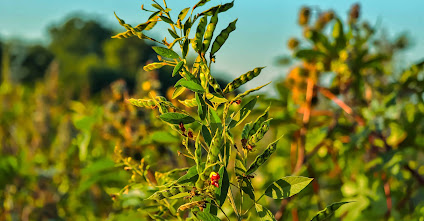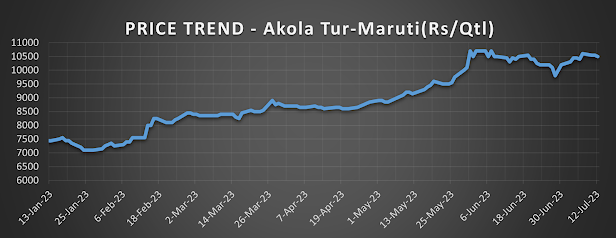Impact of deficient rainfall
State wise Kharif Sowing of Tur
|
State |
Area Covered |
% Change |
|
|
(Lakh Ha) |
|||
|
2023 |
2022 |
||
|
Andhra
Pradesh |
0.064 |
0.075 |
-15 |
|
Arunachal
Pradesh |
0.008 |
0.008 |
0 |
|
Assam |
0.033 |
0.03 |
10 |
|
Bihar |
0.005 |
0.24 |
-98 |
|
Chhattisgarh |
0.003 |
0.192 |
-98 |
|
Gujarat |
0.232 |
0.39 |
-41 |
|
Haryana |
0.013 |
0.003 |
333 |
|
Karnataka |
2.217 |
5.156 |
-57 |
|
Madhya
Pradesh |
0.5 |
0.91 |
-45 |
|
Maharashtra |
1.464 |
6.241 |
-77 |
|
Mizoram |
0.003 |
0.003 |
0 |
|
Nagaland |
0.007 |
0.007 |
0 |
|
Odisha |
0.018 |
0.138 |
-87 |
|
Rajasthan |
0.058 |
0.006 |
867 |
|
Tamil
Nadu |
0.022 |
0.03 |
-27 |
|
Telangana. |
0.724 |
0.948 |
-24 |
|
Tripura |
0.021 |
0.039 |
-46 |
|
Uttar
Pradesh |
0.563 |
0.578 |
-3 |
|
Uttarakhand |
0.04 |
0.04 |
0 |
|
West
Bengal |
0.017 |
0.03 |
-43 |
|
Total |
6.012 |
15.064 |
-60 |
Current status of Tur/Pulses in India
- The
government has a total of 63,724 tonne of tur available with National Agricultural Cooperative
Marketing Federation of India (Nafed) and around 60,000 tonne with National
Cooperative Consumers' Federation of India (NCCF), the Centre’s pulses and
vegetable procuring agency. The quantity available includes imported stocks of
the pulse.
- This comes at a time when pulses inflation is over 6% and sowing for the next kharif season has been negligible amid rainfall deficiency in key growing states such as Karnataka and Maharashtra
- Tur prices in the key mandis of Karnataka and Maharashtra have shot up 41% since January this year, and at present those are ranging at ₹10,000-10,300 a quintal in Karnataka’s Kalaburagi and Maharashtra’s Akola as compared to the minimum support price (MSP) of ₹6,600 per quintal.
- During the last 10 years, India’s production of pulses has gone up about 50%, from 18.3 mt to 27.5 mt because of an increase in production of Chana (chickpea) and moong (green gram). In the case of Tur, though India is the largest producer, accounting for over 80% of production, it is also the biggest consumer. The demand and supply gap are met through imports.
- Tur and urad have a share of over 70% in India’s pulses import basket, and Myanmar is a major producer of both. But on top of a dip in domestic production, Indian importers are reportedly hoarding tur in Myanmar.
- The department of consumer affairs has written to the ministry of external affairs “to ensure regular flow of imports from Myanmar, as India has a Memorandum of Understanding signed with the country to import 250,000 tonnes of urad and 100,000 tonnes of tur through private traders. The Indian embassy in Myanmar is also in talk with the local government and private traders. Production of tur (arhar or pigeon pea) in the ongoing season is estimated to be 2.5-2.8 million tonnes against a domestic consumption of 4.3-4.4 mt.
- Importers of tur and urad are not bringing their purchases from Myanmar to India and hoarding these pulses to book profit amid rising prices in the domestic market.
- After stock limits, India to import 12 lakh tonnes of tur dal to keep prices in check.
- Facing a sharp rise in tur dal prices amid lower production, India will import 12 lakh tonne of the pulse in the current fiscal, up by 35% from the last year, to boost domestic availability and contain price rise.
- The country has imported 6 lakh tonne of tur.
- Imports are undertaken from Myanmar and East African countries. The crop in East African countries will start arriving in August, so the domestic prices will cool down.
- Pigeon peas prices are being closely monitored by the Consumer Affairs Ministry.
- On the other hand, uncertainty continues regarding the stock of pigeon peas in Burma.
- The arrival of the new crop has started in Mozambique. And further production is likely to go up to 4.55.0 lakh tonnes. The crop will reach India by August-September.
- There have been reports of 50-60 percent sowing in Latur, Deglur and surrounding areas of Maharashtra. There is a possibility of delay in arrival of new crop due to delay of rains by 15 days.
- According to the traders, due to the increase in the prices of vegetables, improvement in the demand for tur daal can be seen in the future.
|
Commodity |
State |
Location |
Variety |
12-Jul-23 |
11-Jul-23 |
|
Tur |
Maharashtra |
Solapur |
|
10300 |
10300 |
|
Tur |
Maharashtra |
Amravati |
|
10000 |
10000 |
|
Tur |
Karnataka |
Gulbarga |
Pink |
10200 |
10000 |
|
Tur |
Karnataka |
Gulbarga |
maruti |
10050 |
10300 |
|
Tur |
Maharashtra |
Akola |
Maruti New |
10500 |
10550 |
|
Tur |
Maharashtra |
Akola |
White |
10300 |
10350 |
|
Tur |
Maharashtra |
Latur |
Red/maruti |
10150 |
10000 |
|
Tur |
Maharashtra |
Latur |
Pink |
10100 |
10000 |
|
Tur |
Maharashtra |
Latur |
White |
10200 |
10200 |


Comments
Post a Comment